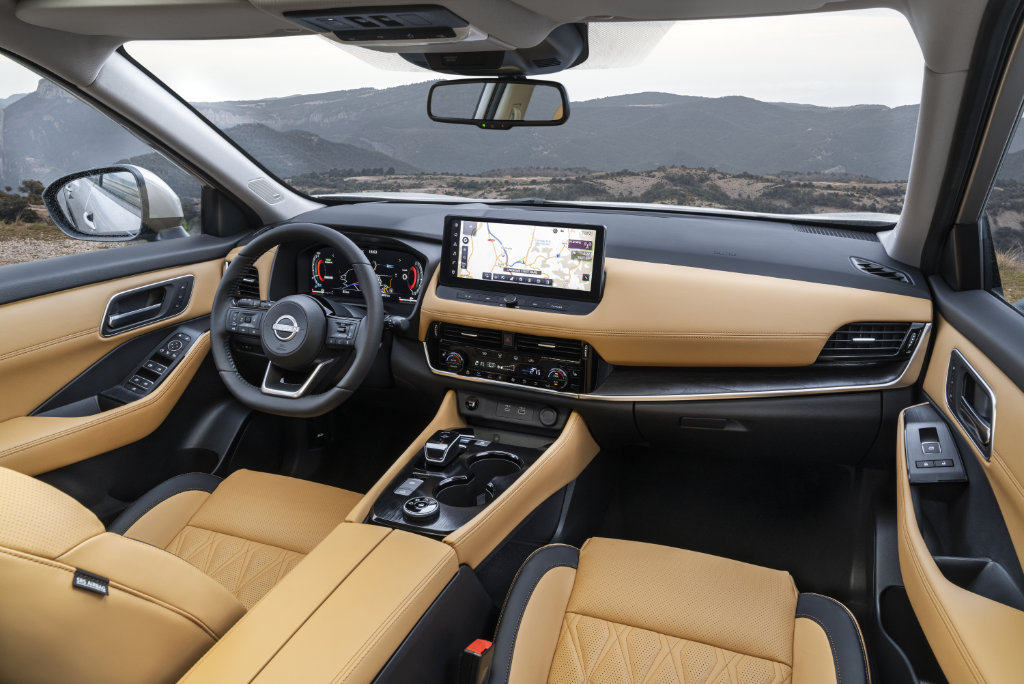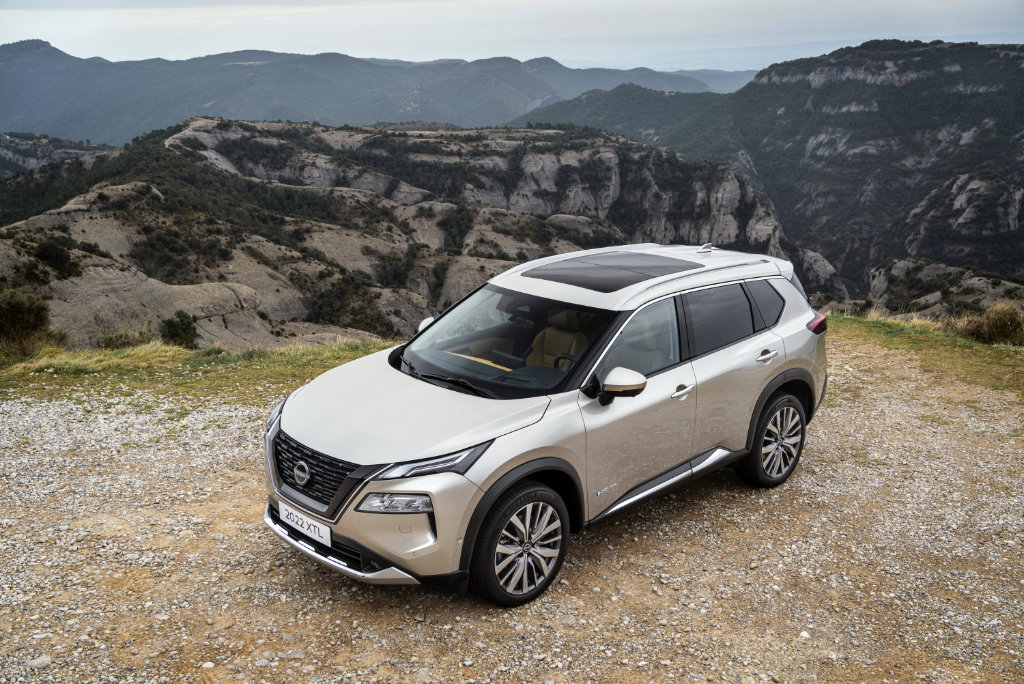
Nissan X-Trail
Nissan’s X-Trail has always suffered something of an identity crisis. It arrived in the UK in 2001 as a tall, gently rufty-tufty estate car with extra ground clearance, all-wheel drive and hoary-handed-son-of-the-soil aspirations. Trouble is, Subaru’s spunky, 60mph-over-stubble-fields-with-a-smile-on-your-fizzog Forester 2.0 litre Turbo had already had its towel on that sun-lounger since 1998, proved a big hit with F Giles and was, frankly, more fun than a room full of nuns with Tourette’s.
Understandably not long, then, before the X-Trail decided it might be better off positioning itself as something of a Qashqai with knobs on, and by its third generation it had the job of replacing both the Mk2 X-Trail and the Qashqai+2, and sizeable psychiatry bills.

In a frantic bid to find some clear water, this Mk4 X-Trail e-Power bills itself as the only seven-seat electrified SUV in its segment. Quite what said segment might be seems open to debate, though: as rivals, Nissan cites Toyota’s RAV4, which it used as a benchmark for this fourth generation X-Trail, as well as the likes of the Skoda Kodiaq, Mazda CX-5 and VW Tiguan Allspace. I’d be more inclined to favour the Hyundai Santa Fe, Toyota Highlander and Kia Sorento, all of which Nissan pooh-poohs as too large…
Anyway, mild role-in-life and segment placement dust-ups aside, the new X-Trail has shed its crossover pretentions in favour of added SUV chunk and headlamp housings that run so far back atop the front wings it can’t be long before someone actually integrates them into the A pillar.

The interior’s pretty classy. Top-of-the-range variants are swathed in tactile, cappuccino-hued leather which lifts the cabin elegantly above the usual chthonic, all-black SUV offering that the British, says Nissan, prefer. The quality of fit and finish is first class, even unto the ‘laser guided stitching’ which ensures that the needle never violates any of the perforations in the leather seat cladding.
Mercifully, Nissan is one of the manufacturers that, having seen what a cock-up many are making of all-touch-screen infotainment operation, is happy to leave the important knobs alone, including the air-conditioning controls and a centrally located audio volume control.
There’s no evidence of the Qashqai parts bin here save two 12.3-inch screens, which serve the driver, and a central multi-information system, whilst a whopping 10.8 inch head-up display occupies so much windscreen space you’ll want to dim it almost to the point of obscurity. Nissan boasts that this all adds up to ‘35 inches of infotainment’; a statement I’m not sure I wish to dwell on overmuch… Connectivity includes Android Auto and Apple CarPlay -the latter wireless- and in-car wi-fi for up to seven devices.

Though soft-touch mouldings do bizarrely still frequent surfaces that no one will ever touch except to dust, the scratchy plastics previously prone to sneak aboard on door cards and centre consoles have all vanished. Hoorah. Ergonomics give no cause for complaint, the driver’s seat is comfortable and the driving position spot on.
Accessed by the 85 degree opening rear doors loved by Qashqai owners, the second row seats have a 220mm sliding range to guarantee legroom for even the lankiest, and the flat floor afforded by electric power astern means the short straw in the centre seat will at least have somewhere to put their feet. Better yet, the rear bench’s sensible 40:20:40 split/folding format allows two adults to comfortably share their accommodation with skis or the occasional post-taxidermy ostrich.
Though the third row seats do offer space for feet under the row ahead, they’re designed with a height limit of 1.6 metres in mind, so only masochistic adults need apply. As usual, erecting the third row annihilates loadspace, which promptly shrinks from a respectable 585 litres to a volume appropriate only for a lightly anaesthetised sea otter, making a roof-mounted luggage lozenge pretty much compulsory for any journey involving an overnight.

So, to ‘e-Power’; a self-charging, electric motor drive powertrain. I suppose, in as much as both internal combustion and electric power sources are involved, you might call it a hybrid. But in this case, Nissan’s gently novel e-Power system relegates a 1.5 litre variable compression ratio, turbocharged petrol engine to the sole job of charging the 2.1kWh battery, whilst power is provided to the front wheels by a 150kW electric motor delivering peak output of 201bhp.
This e-Power system first broke cover in the Qashqai, but the X-Trail variant I’m driving today features a first in the form of four-wheel drive, called e-4orce (uck), which adds a 100kw electric motor to the rear axle for a total system output of 211bhp and the promise of 0-62mph in 7.2 seconds with enhanced traction, handling and ride comfort.
Why not a conventional EV or a standard, series/parallel hybrid, I hear you cry? It’s all about driving feel, Nissan tells us. e-Power combines the most efficient use of the petrol engine with a small battery and a quiet, smooth EV driving experience.

Nissan also points out that, as ‘bridge technology’ e-Power is a better proposition globally as a stepping-stone to full electrification than either a plug-in hybrid or a full EV. That, given that charging posts won’t be sprouting willy-nilly on the slopes of Mt Kilimanjaro any time soon, seems sound thinking.
Largely, the system works well. Power delivery is indeed smooth and quiet; with the engine only operating to charge the battery, you are spared those accompanying hybrid noises-off suggesting they’re rustling cattle under the bonnet, though protracted periods of hill climbing will still elicit mooing as the engine perks up somewhat vocally to keep the battery interested.
But this isn’t a car set up to encourage Axminster crushing, and if you drive it with an ear on keeping things muted in the engine room it rewards with tidy handling, light, precise steering, well-controlled corning posture and a supple ride the underlying firmness of which only surfaces on the very worst, um, surfaces.

On the whole, the driving experience is rather serene. But definitely best piloted as if you’re keen to avoid having the rear of the cabin flecked by toddler puke. The powertrain is at its happiest, smoothest and quietest if not pushed to deliver ramming speed; the engine remaining admirably muted even whilst you’re overtaking, as long as you don’t push too hard.
Besides, there’s not a deal of fun to be found in flinging the thing around. Rather, the dynamic emphasis is sensibly focused on a comfortable ride at cruising speed, steering light enough that there’s no danger of it turning your Bingo wings into condoms stuffed full of walnuts, and nicely planted, drama-free cornering with excellent body control. Shod with 20-inch wheels, the X-Trail can become quite crashy on poorer surfaces at low speeds, and urbanites might be happier with a taller tyre wall coming to the rescue.
The e-Power system is equipped with the usual selection of driving modes, but progress in Eco mode is like swimming in wellingtons – a deal of activity for not much forward motion, and Sport mode tends to promote a tad too much bovine protest from the engine room without overmuch added reward. An e-Pedal button ups braking regeneration to the point where you can readily drive on one pedal alone. This is useful for the urban drudge that will apparently occupy the life of 70% of X-Trails, but, on the open road, does feel as if someone has mischievously tied a large rubber band to the back bumper…
Pottering mode also reaps rewards from a system that seems remarkably efficient, being a good 15-20% more economical than the mild hybrid X-Trail, and returning a quoted average fuel consumption of about 43.5mpg. The lack of battery weight must help; this AWD X-Trail weighs in at some 1880kg, whilst the battery pack of a conventional EV would surely nudge the needle a good 200kg more round the dial…
Under braking, the Nissan disguises its bulk admirably. The e-Power system incorporates brake torque vectoring, which promises, and appears to deliver, better control and handling with less pitching under braking. For all that, I found response to the first press of the pedal a whiff more indolent than I’d have liked. Perhaps we’ve all become spoiled by the instant grab of the over-servo’ed?

Off-road, firstly on amusingly slippery gravel tracks and then a small, more arduous course carefully tailored to ensure successful completion by even the most ham-fisted, the X-Trail acquitted itself predictably handsomely; the electric four-wheel drive system allegedly promoting better torque control and quicker responses than mechanical counterparts.
Shame there was no wet gymkhana grass about though. Axle articulation beards will tell you that this one off-road surface most X-Trails may actually ever encounter is, ironically, about as severe as it gets.
All-in-all, then, this is an interesting take on range anxiety-free EV motoring whilst we wait for the UK’s charging infrastructure to become even remotely adequate.
By equipping the new X-Trail with both e-4orce electric all-wheel drive and seven seats, and styling it more like an SUV than a crossover, Nissan clearly hopes to prise back open the gap between this car and the Qashqai to give it a tad more of a fighting chance on the showroom floor.

It isn’t going to set the world on fire, but it has been pretty carefully crafted to offer as close to all things to all family members as any car in this class could hope to. Plus you won’t have to waste hours interrupting long journeys to pointlessly drink disgusting Starbucks coffee, because the charging post is under the bonnet.
Sure, anything with electric motor drive which still bangs out CO2 at the rate of 147g/km is bound to elicit some head scratching, but if we all looked at well-to-wheel CO2 emissions for EVs rather than just their exhaust pipes (to wit, the fuel used to generate the electricity charging the car), it would be a different story.